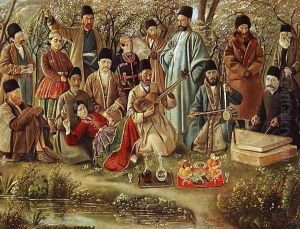Kamal-Al-Molk Paintings
Kamal-Al-Molk, born Mohammad Ghaffari in Kashan, Iran, was a pivotal figure in the transition of Persian art to contemporary Iranian art. His birth in 1847 into a family with a strong artistic heritage set the stage for his future contributions to the world of Persian painting. His uncle, Mirza Abolhassan Khan Ghaffari, known as Sanee-ol-Molk, a celebrated painter of the time, was instrumental in Kamal-Al-Molk's early artistic education.
Kamal-Al-Molk's talent became apparent early on, and he was brought to Tehran where he continued his education under the tutelage of his uncle. His skills garnered the attention of Naser al-Din Shah Qajar, the ruling monarch, who became his patron. The Shah sent him to Europe to study the arts upon the recommendation of his uncle. During his time in Europe, Kamal-Al-Molk was exposed to the techniques of the European masters, and he became proficient in the realistic style.
Upon his return to Iran, Kamal-Al-Molk embarked on a mission to reform the arts within his country. He established the Sanayeh College in 1911, which later became known as the Kamal-ol-Molk School and eventually evolved into the Faculty of Fine Arts at the University of Tehran. This institution was instrumental in educating a new generation of Iranian artists. Kamal-Al-Molk's influence extended beyond his own paintings, as he played a key role in modernizing Iranian art education and practice.
His works often depicted realistic portrayals of everyday life, as well as the Iranian landscape and royal court. He was known for his exquisite attention to detail and his ability to capture light and texture, which was a marked departure from the traditional Persian miniature style that had dominated for centuries.
Kamal-Al-Molk's legacy is not only in the paintings that he left behind but also in the shift he created in the Iranian art scene. His insistence on realism and observation-based painting set a new standard that influenced many artists who followed. He continued to paint and inspire until his death in 1940 in Nishapur. Kamal-Al-Molk remains one of the most respected and influential figures in the history of modern Iranian art.
